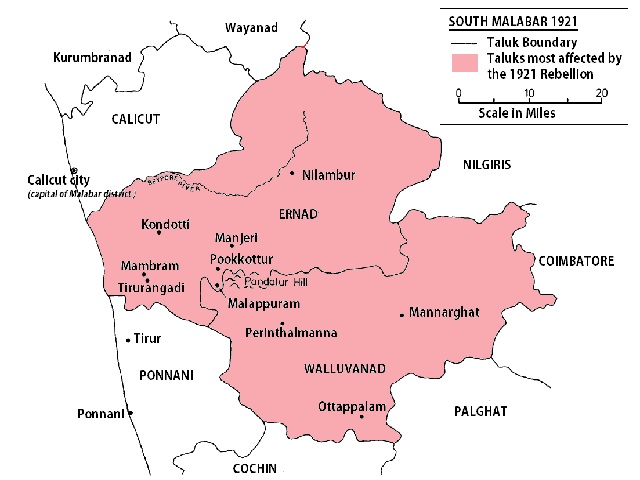The Malabar Rebellion happened from August 20, 1921 to 1922 in Malabar region of Kerala. It was also known as the Moplah massacre, Moplah riots and Mappila riots. Take a look at the details of this peasant movement below.
What was the Malabar Rebellion?
Three small in stature but large in impact movements took place in the British era. These were Tribal movements, Peasant movement, Agrarian movement.

Moplah riots began in 1921. This was a peasant movement led by the Moplah community in Kerala. These people attacked their landlords and British premieres. It can also be called as the first national movement in South India.
Span of the Movement:
- The movement started as the resistance against British colonial rule and the course also changed when the peasants rose against the prevailing feudal system controlled by elite landlords who were basically Hindus.
- The riots led to the deaths of hundreds of people in the Malabar region as the movement was very unorganized and the farmers there used to generally attack the government buildings, or places controlled by British and the elite landlords.
- The rebels also attacked many institutions of the colonial state, such as telegraph lines, train stations, courts and post offices.
- Keeping in mind a few historical accounts, it was found that this uprising led to a loss of 10,000 lives which included 2339 rebels.
Reason of the Clashes:
Many historians state that there were a series of clashes between the Mappila peasantry and their landlords. It was supported by the British government for the 19th and 20th century. However the Khilafat movement met with a firm suppression by the British which was in turn met with resistance in Eranad and Valluvanad taluks of Malabar.
Initially this movement was supported by Mahatma Gandhi.
The trigger of this uprising was pulled after the Non Cooperation Movement was launched in 1920. Tenancy laws favoured the landlords and exploited the farmers which is why the movement began.
These landlords were basically Namboodri Brahmins while most tenants were Mappila Muslims.
Various fiery speeches were given by Muslim religious leaders there that invoke the anti British sentiments in people and a series of attacks were launched
The end of the Movement:
The movement ended in 1921 and was crushed by the Brtishers. They raised a special battalion called the Malabar Special Force for this riot.
Wagon Tragedy:
In November 1921, 67 Moplah prisoners were killed while being transported from Tirur to Central Prison in Paodanur. They died of suffocation in a closed freight.
Also read|
| Who is Hari Singh Nalwa? All about the most feared Sikh warrior in Afghan history | GK Questions and Answers Independence Day: Quit India Movement |
Rebels who were sentenced to death after the Movement's end
- Ali Musliyar, leader of the rebellion
- Kunhi Kadir, Khilafat Secretary, Tanur
- Variankunnath Kunhammad Haji
- Kunhj Koya, Thangal, President of the Khilafat Committee, Malappuram
- Koya Tangal of Kumaramputhur, Governor of a Khilafat principality
- Chembrasseri Imbichi Koya Thangal, who killed 38 men by slashing their necks and throwing them into a well
- Palakamthodi Avvocker Musaliar
- Konnara Mohammed Koya Thangal.
Malabar Movement has completed 100 years this year and has many chances of being put up as a question in the competitive exams this year.
Comments
All Comments (0)
Join the conversation